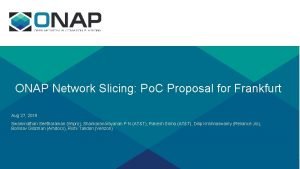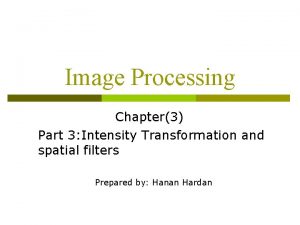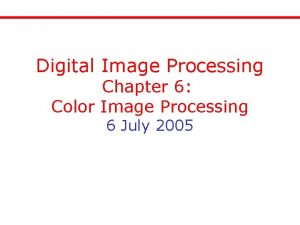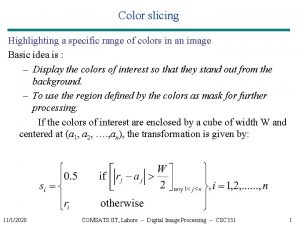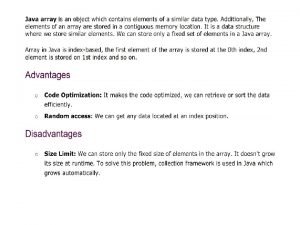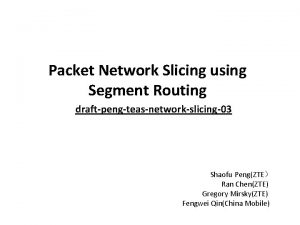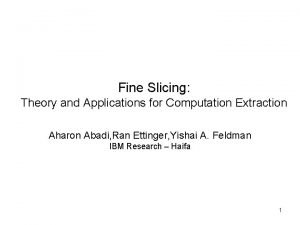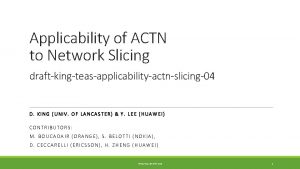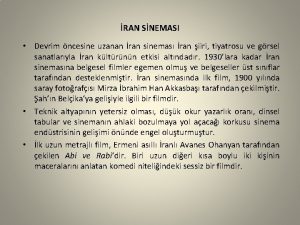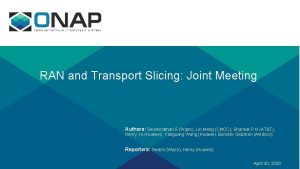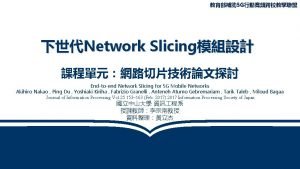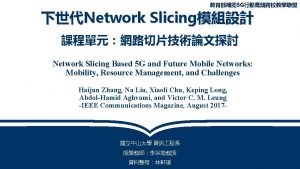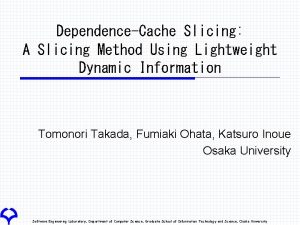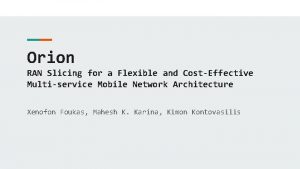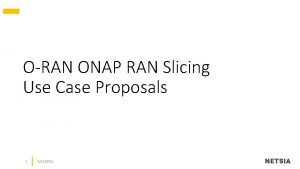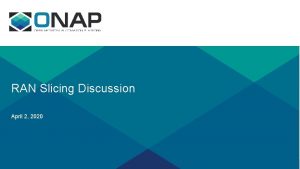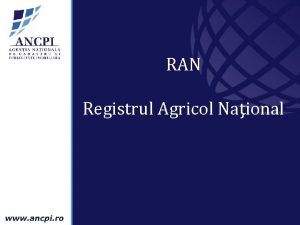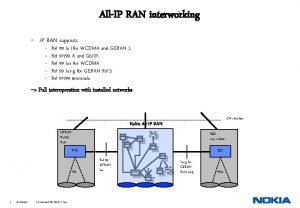RAN and Transport Slicing Part of the E

























- Slides: 25

RAN and Transport Slicing (Part of the E 2 E Network Slicing Use Case) Participants: CMCC, Wipro, Huawei, AT&T, Amdocs, Fujitsu, Verizon, Reliance Jio, Tencent, China Telecom Authors: Swaminathan S (Wipro), Lin Meng (CMCC), Shankar P N (AT&T), Henry Yu (Huawei), Yaoguang Wang (Huawei), Borislav Glozman (Amdocs) Reporters: Swami (Wipro), Henry (Huawei), Yaoguang Wang (Huawei) April 23, 2020

ONAP-based Slice Management Overall Architecture Choices: Recap 1 OSS/BSS/Apps 2 OSS/BSS/Apps 3 OSS/BSS/Apps Standard APIs To Be Done in G CSMF (ONAP) release CSMF NSMF (ONAP) OSS/BSS/Apps x. NFs 3 rd NSSMF(s) (ONAP) x. NFs OSS/BSS/Apps Standard APIs CSMF (ONAP) CSMF NSMF (ONAP) NSMF NSSMF(s) x. NFs Standard APIs NSSMF(s) (ONAP) 5 Standard APIs NSMF (ONAP) 4 NSSMF(s) x. NFs NSSMF(s) (ONAP) x. NFs In F release, only Scenario 4 for Core is implemented. Scenario 1 & Scenario 4 for RAN and. Core will party component be supported in G release and following releases. Subsequently, remaining scenarios 2, 3, 5 can be easily realized.

Options for NSSMFs in Guilin RAN and Transport Slicing Overview ONAP CSMF Align with 3 GPP (Note) 3 rd Party RAN NSSMF RAN Slice Subnet TN TSCi (IETF draft) NSMF Align with O-RAN Transport Slice Subnet RAN NSSMF within ONAP CMCC, Wipro, AT&T, Amdocs, QCT, Verizon, Reliance Jio, Tencent, China Telecom 3 rd Party RAN NSSMF Huawei, CMCC, Wipro TN NSSMF within ONAP Huawei, CMCC, Fujitsu, Wipro Core NSSMF TN NSSMF Transport Network Configurations Configure RU, DU, CU RU RAN Slice Subnet DU TN CU TN Front Haul Mid Haul Back Haul Transport Slice Subnet 1 Transport Slice Subnet 2 Transport Slice Subnet 3 Note: Enables interface with external NSSMF. Involved Companies Core Slice Subnet Cross Domain Links, Domain NSSMF do not know both ends. It is managed by NSMF.

RAN Slicing for Guilin Release

RAN Sub-net Slicing: Proposal for Guilin ONAP shall: RAN slice inventory • Select RAN NSSI, determine RAN slice sub-net resources and then configure the RAN slice sub-net including: o Association of x. NFs to a Slice sub-net instance o Allocation of ‘resources’ for a slice sub-net instance o Configuration of RAN for a slice sub-net instance (including cell configuration such as bandwidth, etc. ) ONAP O 1/O 2 • Consume necessary PM/FM info from RAN, for KPI monitoring/Closed Loop Actions/Intelligent Slicing (details to be worked out) • Re-configure/re-allocate RAN resources (under discussion). Assumptions • All RAN x. NFs are created and pre-configured • *** Configuration & Persistency Service is assumed to contain cell details including PNF mapping, etc. • Southbound interface from SDN-C (R) will be netconf for CM, and VES for FM/PM. We intend to align with O-RAN where feasible. - List of cells, DUs, CUs with details of active slices - Capacity & Capability of RAN subnet RAN RUs Near RT-RIC DUs CUs Discussion Points 1. Slice sub-net “configuration” – attributes, flows. 2. PNF discovery, capabilities discovery/configuration, capacity 3. 4. 5. 6. information Cell and topology discovery/configuration relevant to Slicing Role of Near-Real-time RIC & interactions in the context of RAN Slicing PM/FM notifications Availability of specs/inputs for alignment (e. g. , O-RAN)

(RAN) NSSMF in ONAP– Functions & Classification Function Yellow Not in Guilin scope Blue Partly in Guilin scope Description Classification Proposed ONAP Component(s) Determine if an existing NSSI can be used, or a new one is needed Optimization OOF (triggered by SO) Determine resources to be allocated to the NSSI (for a new NSSI) (Some parts such as PCE may be part of Domain Controllers) Optimization OOF (triggered by domain controllers) Instantiate/scale up necessary (virtual) resources (using NFVO) Orchestration SO Perform necessary (re) configuration (incl. NSSI stitching configs) Configuration Domain controllers (Note 2) NSSI (De)Activation (De) Activate the NSSI resources Configuration Domain controllers NSSI Modification Determination of modifications to be done Optimization OOF Resource modification (re-allocation, scaling) Orchestration SO, Domain controllers (Re) Configuration of resources Configuration Domain controllers NSSI details exposure Provide details of NSSI to NSMF, inventory (resources, capabilities) Orchestration SO, Domain controllers NSSI Closed Loop Perform closed loop control actions such as scaling Orchestration SO, Domain controllers (Note 3) NSSI De-Allocation Tear down the NSSI and reclaim resources used Orchestration SO NSSI Allocation Notes Update configurations Configuration Domain controllers 1. SO triggers the NFVO (ref. 3 GPP) to perform all virtual resource allocation & orchestration actions related to an NSSI. NFVO may be slice unaware. 2. Domain Controllers – include SDN-C (R), VF-C, APP-C. 3. Some closed loop actions may be performed by SO, while some by SDN-C for example.

Preparation (existing network) Green-field vs Brown-field deployments Green-field scenario Brown-field scenario Instantiation of required VNFs using existing ONAP service framework Remark: Hybrid scenarios, i. e. , brownfield for some sub-nets while green-field for others is also possible. AN Initial Configuration of virtual (VNFs, links), physical (PNFs) and logical resources (cells) Determine slice sub-net resources to be instantiated/ allocated Instantiation/scaling of required VNFs TN Basic configuration of virtual (VNFs, links), physical (PNFs) and logical resources (cells) Determine slice sub-net resources to be allocated Slice-specific configuration of virtual (VNFs, links), physical (PNFs) and logical resources (cells) (Note) Trigger for network slice allocation CN Slice-specific configuration of virtual (VNFs, links), physical (PNFs) and logical resources (cells) Note: This may also involve scaling of virtual resources (e. g. , VNFs) 7

RAN Slice subnet allocation: Pre-requisite (prior preparation) • (O-)RAN service provisioning procedures are completed including: - (O-)RAN Virtualized Part Setup and Initial Configuration (non-slicing related) - PNF Registration and Configuration (Ref. : O-RAN WG 1 Operations and Maintenance Architecture) • CUs, DUs, Near-RT RIC, Fronthaul are all setup and configured (basic configuration, without the network slicing parts). • For configuration, we will use information models from 3 GPP TS 28. 541. (for example, NRCell. CU, NRCell. DU) 8

External RAN NSSMF for Guilin Release

High-level Proposal • The motivation is to complete the RAN NSSMF solution for option 4, integrate ONAP with third-party RAN NSSMF. NSMF Portal CSMF Portal U-UI EXT-API (CSMF NB interface) SDC (test only) SO Service instance Service Profile NST, NSI NSMF Slice Profile Standard APIs RAN NSSMF (3 rd party) Note: In R 6, external CN NSSMF was supported. In Guilin, external RAN NSSMF is proposed to support E 2 E NSI Life Cycle. A&AI CSMF CST NSST Policy OOF RAN NSST, NSSI CN NSSMF (3 rd party) CSMF PNF details NSMF NSSMF External NSSMF 10

Impacts to ONAP components (Under Discussion) Function Provide a full E 2 E Slicing solution involving RAN, Transport and Core NSSMF, and connecting to external Core/RAN NSSMF Impacts for External RAN NSSMF interaction • Enhancements in A&AI to support RAN slicing, such as Slice Profile, Service Profile and CS Profile, etc. • Impacts in OOF for NSI/NSSI selection to be analyzed. • Impacts in Policy to be analyzed. • Updates in SO slicing workflows to support E 2 E slicing • Enhancements in SO NSSMF adapter to support RAN slicing, with standard 3 GPP APIs) • Enhance allocate. NSSI and modify. NSSI, etc • 3 rd-party RAN NSSMF simulator for integration test automation (support standard 3 GPP APIs) • allocate. NSSI • deallocate. NSSI • modify. NSSI • get. NSSI • Etc Impacted components A&AI, OOF, Policy, SO, Integration Note: PM/FM data reporting from external RAN NSSMF to ONAP (NSMF) is still under discussion. 11

Transport Slicing for Guilin Release

Scope for Guilin Release E 2 E NS controller, RAN Slice controller, CORE Slice controller TSCi (draft-rokui-5 G-transport-slice) 1. Implement TSCi (i. e. , create TS definition model) Transport Slice Definition Model Transport Slice Implementation Models ACTN TE / L 0/L 1/L 2 models Optical Domain Controller Optical Network 2. L 1 (OTN) and L 2 (E-line) service slicing NOTE: many existing CCVPN features can be reused. NOTE: could also leverage MDONS L 1 (OTN) using TAPI as implementation models. Assumption Transport slicing solution includes 2 level of abstraction models: Transport Slice Definition Model and Transport Slice Implementation Model. Approach We propose IETF-draft based approach for realizing Transport slicing. 13

TSCi Information Model 14

Definition Model Implementation Model TSCi on ONAP: TN NSSI Model in A&AI TN NSSI Transport Slice Policy Network Transport_Slice_ID Network_ID Policy_ID Transport_Slice_Name Transport_Slice_Policy List [Policy_ID] Policy_Type (e. g. , SLA, selection, assurance) Network_Slice_Info List [S_NSSAI] Network List [Network_ID] Node List [Node_ID] Link List [Link_ID] SLA Policy Network Slice Info S_NSSAI Node Tenant_ID Node_ID Service_Type (e. g. , CCTV, infotainment, etc. ) Endpoint List [endpoint_ID] reliability Link_ID Endpoint_A latency jitter reliability Selection Policy Technology_Type (e. g. , L 2 VPN, L 3 VPN) Tunnel_Type (e. g. , client-signal, E-LINE) Assurance Policy Assurance_Type Time_Interval Endpoint_B 15

Definition Model Implementation Model TSCi on ONAP (2): Used As Both Internal & External Interface Standard Restconf APIs (TSCi) EXT-APIs OSS/BSS/Apps CSMF (ONAP) ONAP Internal call aligned with 3 GPP SO AAI NSMF WF Internal APIs (TSCi) TN NSSMF WF TSCi model • TSCi Data Model is a YANG module • Augmentation of the ACTN VN model; still under development in IETF. Draft will be released this year. • RESTCONF/NETCONF interface NSMF (ONAP) Internal call aligned with TSCi TN NSSMF (ONAP) TSCi Data Model (RESTCONF/YANG) TN NSSMF x. NFs 16

Transport & RAN Slicing Interactions

Support for 2 deployment scenarios CSMF NSMF RAN NSSMF Transport NSSMF Core NSSMF RAN subnet Transpor t subnet Core subnet Deployment Scenario 1 Deployment Scenario 2 • RAN subnet is managed by RAN NSSMF. • RAN subnet is composed of: o RAN NFs subnet (managed by RAN NSSMF o Fronthaul & mid haul subnets (managed by Transport NSSMF) • RAN NSSMF decomposes RAN Slice profile into RAN NFs Slice Profile, Fronthaul Slice Profile & Mid haul Slice Profile • RAN NSSMF contacts Transport NSSMF for allocating FH/MH NSSI • RAN subnet is managed by RAN NSSMF. • Transport subnet is composed of: o Fronthaul subnet o Mid-haul subnet o Backhaul subnet • Transport NSSMF decomposes Transport Slice Profile into Fronthaul Slice Profile, Mid haul Slice Profile & Backhaul Slice Profile • For connectivity of RAN, FH and MH, Transport NSSMF and RAN NSSMF interact with each other (or via NSMF)

Scenario 1 Note: The interaction between RAN and Transport NSSMF may be direct, or through NSMF Transport NSSMF (Backhaul) RAN NSSMF Transport NSSMF (Fronthaul) RU FH subnet Core NSSMF Transport NSSMF (Midhaul) DU RAN subnet MH subnet CU BH subnet Core subnet

Scenario 1 CSMF NSMF 1 RAN NSSMF TS_3 TS_4 1 a RAN NFs Subnet 2 1 b-ii Fronthaul subnet TS_1 Transport NSSMF 3 Core NSSMF 2 a • TS_1 is backhaul transport slice; TS_3, fronthaul; TS_4, midhaul. 3 a 1 b-iii Mid haul subnet Backhaul subnet Core subnet • TN MD (T-NSSMF) receives TS_1 from NSMF (step 2), and TS_3 and TS_4 from RAN NSSMF (step 1 b-i). • TN MD then configures backhaul (2 a), fronthaul (1 b-ii), and midhaul (1 b-iii), respectively.

Scenario 2 NSMF RU FH subnet Core NSSMF Transport NSSMF (x. Haul) RAN NSSMF DU RAN subnet MH subnet CU BH subnet Core subnet

Scenario 2 CSMF NSMF TS_1 2 1 RAN NSSMF TS_3 TS_4 3 Transport NSSMF • TS_1 is backhaul transport slice; TS_3, fronthaul; TS_4, midhaul. Core NSSMF • TN MD (T-NSSMF) receives TS_1, TS_3 and TS_4 from NSMF (step 2). 1 a 2 a-ii RAN NFs Subnet Fronthaul subnet 2 a-iii Mid haul subnet 2 a-i Backhaul subnet 3 a Core subnet • TN MD then configures backhaul (2 a-i), fronthaul (a 2 -ii), and midhaul (2 a-iii), respectively.

Cross Domain Interaction Cross Domain Topo. Inventory System NSMF c If new NSSI, check connection points of AN, get the connection points of TN(from itself or inventory sys). a Allocate AN NSSI d Allocate TN NSSI based on the result of step c. one or more TN NSSI needed. b NSSI Details, including the connection points. TN NSSMF AN NSSMF TN AAU Front Haul Transport Slice Subnet 1 Access Slice Subnet DU TN Mid Haul Transport Slice Subnet 2 CU TN Core Back Haul Transport Slice Subnet 3 Cross Domain Links, Domain NSSMF do not know both ends. It is managed by NSMF/Inventory System. Core Slice Subnet

Comparison Scenario 1 Scenario 2 Hierarchy An e 2 e slice is composed of RAN, Core and Transport backhaul sub-nets. RAN sub-net is composed of RAN NFs, FH and BH sub-nets. An e 2 e slice is composed of RAN, Core and 3 Transport sub-nets. (Note) RAN slice profile decomposition RAN NSSMF is responsible for decomposing RAN slice profile into slice profiles for RAN NFs, FH and BH NSMF is responsible for determining FH, MH and BH slice profiles (Note). Cross-domain interaction RAN NSSMF shall have to know from TN NSSMF (or from NSMF) the interconnection for RAN NFs (FH, BH) and establish connectivity NSMF shall be responsible for crossdomain connections (RAN NFs, FH, MH, BH, Core) RAN NSSMF shall have to know TN NSSMF NSMF shall be responsible for all cross details in case of east-west communication (or -domain NSSMF interactions. RAN ‘controlling’ a TN NSSMF for FH/BH) Note: NSMF may also simply send a Transport Slice profile to TN NSSMF may then decompose it int FH, MH and BH slice profiles. However, this may cause dependencies and interop issues when using multiple transport options and different transport segments realized using multi-vendor products/technologies.

s Thank You!
 Sequenza segnale
Sequenza segnale Antiporters
Antiporters Active transport
Active transport Passive trnasport
Passive trnasport Now answer the following questions
Now answer the following questions Active transport vs passive transport venn diagram
Active transport vs passive transport venn diagram Endocytosis vs exocytosis
Endocytosis vs exocytosis Primary active transport vs secondary active transport
Primary active transport vs secondary active transport Bioflix activity membrane transport active transport
Bioflix activity membrane transport active transport Bioflix activity membrane transport active transport
Bioflix activity membrane transport active transport Slicing and dicing in cognos
Slicing and dicing in cognos Rgb
Rgb Slicing and dicing in olap
Slicing and dicing in olap Ts28.531
Ts28.531 Network slicing nssai
Network slicing nssai Intensity slicing in image processing
Intensity slicing in image processing Intensity to color transformation
Intensity to color transformation Colour slicing
Colour slicing 45 degree haircut milady
45 degree haircut milady Java array slicing
Java array slicing Slicing
Slicing Network slicing with segment routing
Network slicing with segment routing Network slicing simulator
Network slicing simulator Fine slicing
Fine slicing Network slicing draft
Network slicing draft Program slicing tool
Program slicing tool













